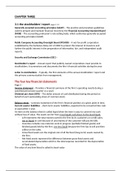Zusammenfassung
Summary chapters 3-4-5-10-15 | Principles of Managerial Finance, Global Edition, ISBN: 9781292018201 Financial Management 2 (2060FM2_19)
- Kurs
- Hochschule
- Book
Detailed summary of chapter 3-4-5-10-15 for the Financial Management 2 exam in year 2 - summary has all equations needed during the exam and mentions in the chapters listed in red. All concepts are easily found by searching the word in the search bar.
[ Mehr anzeigen ]




